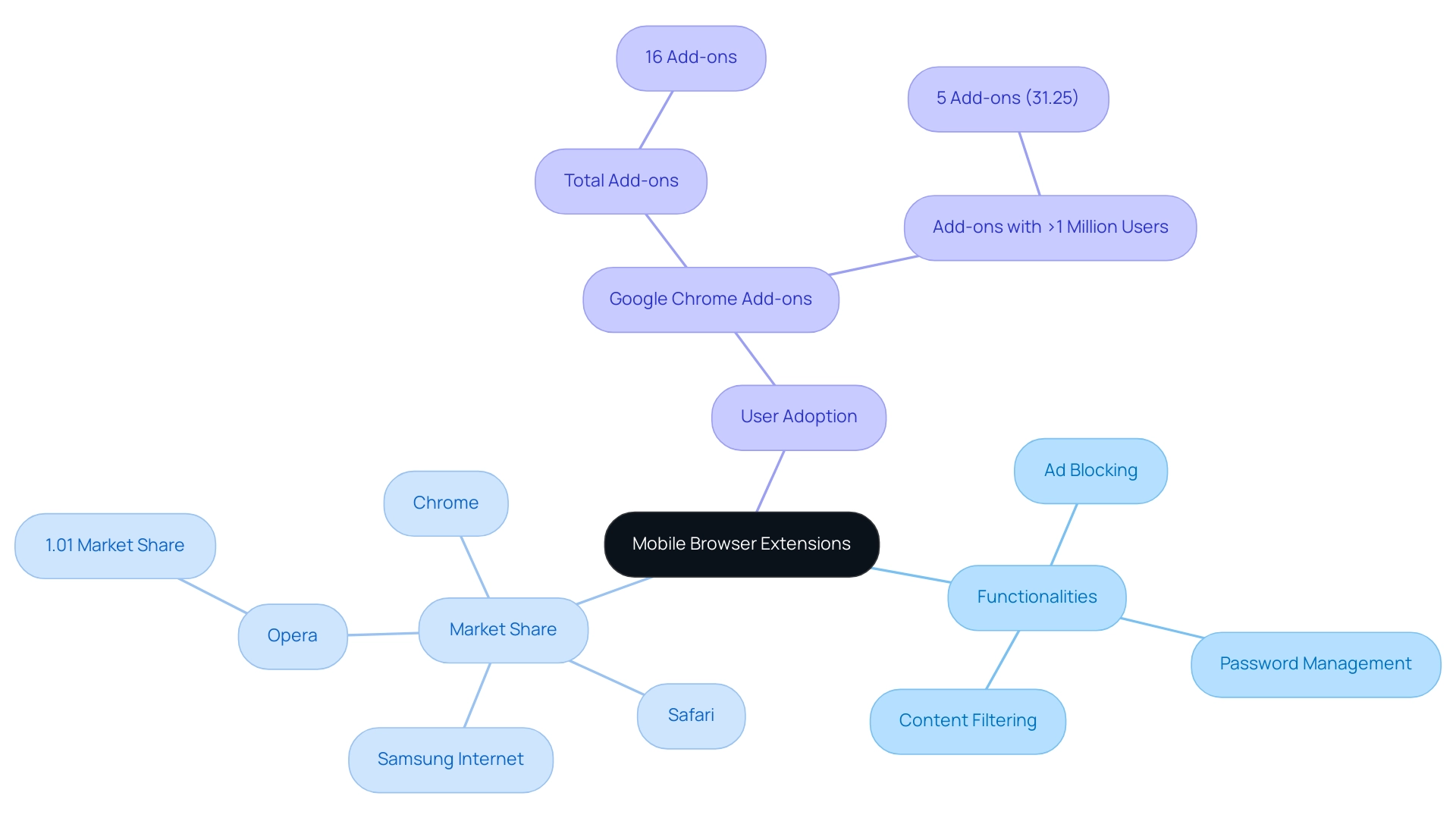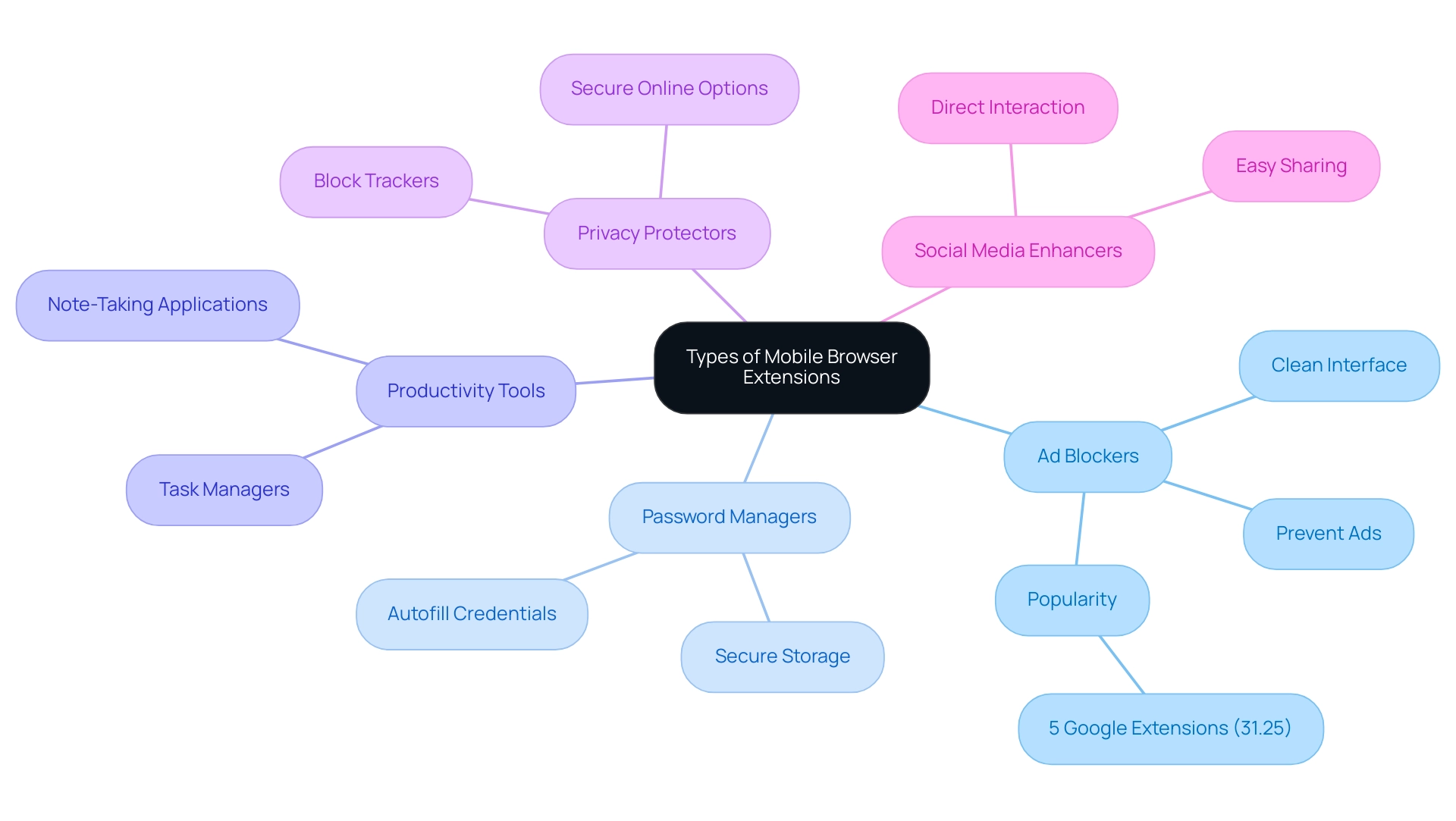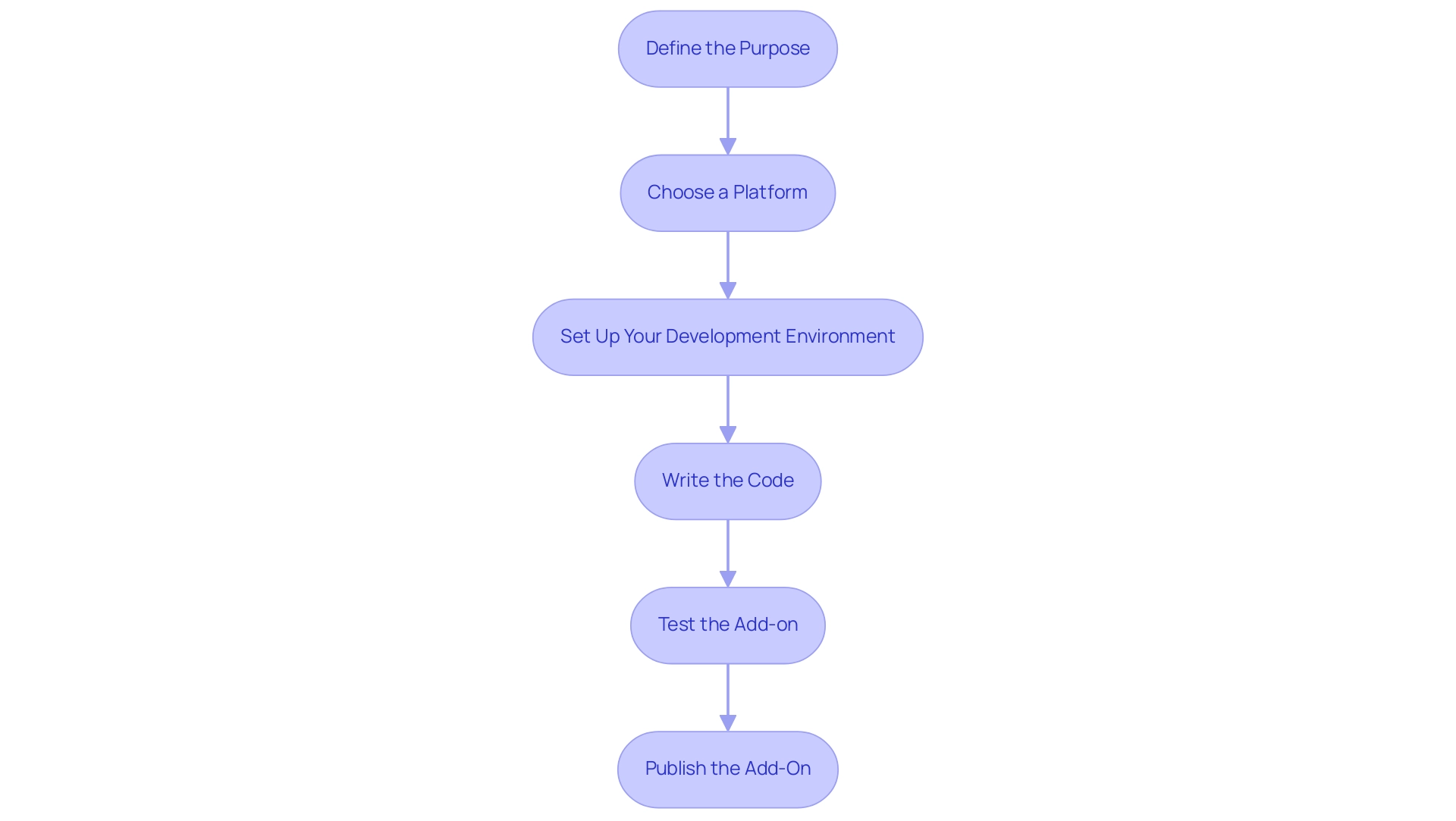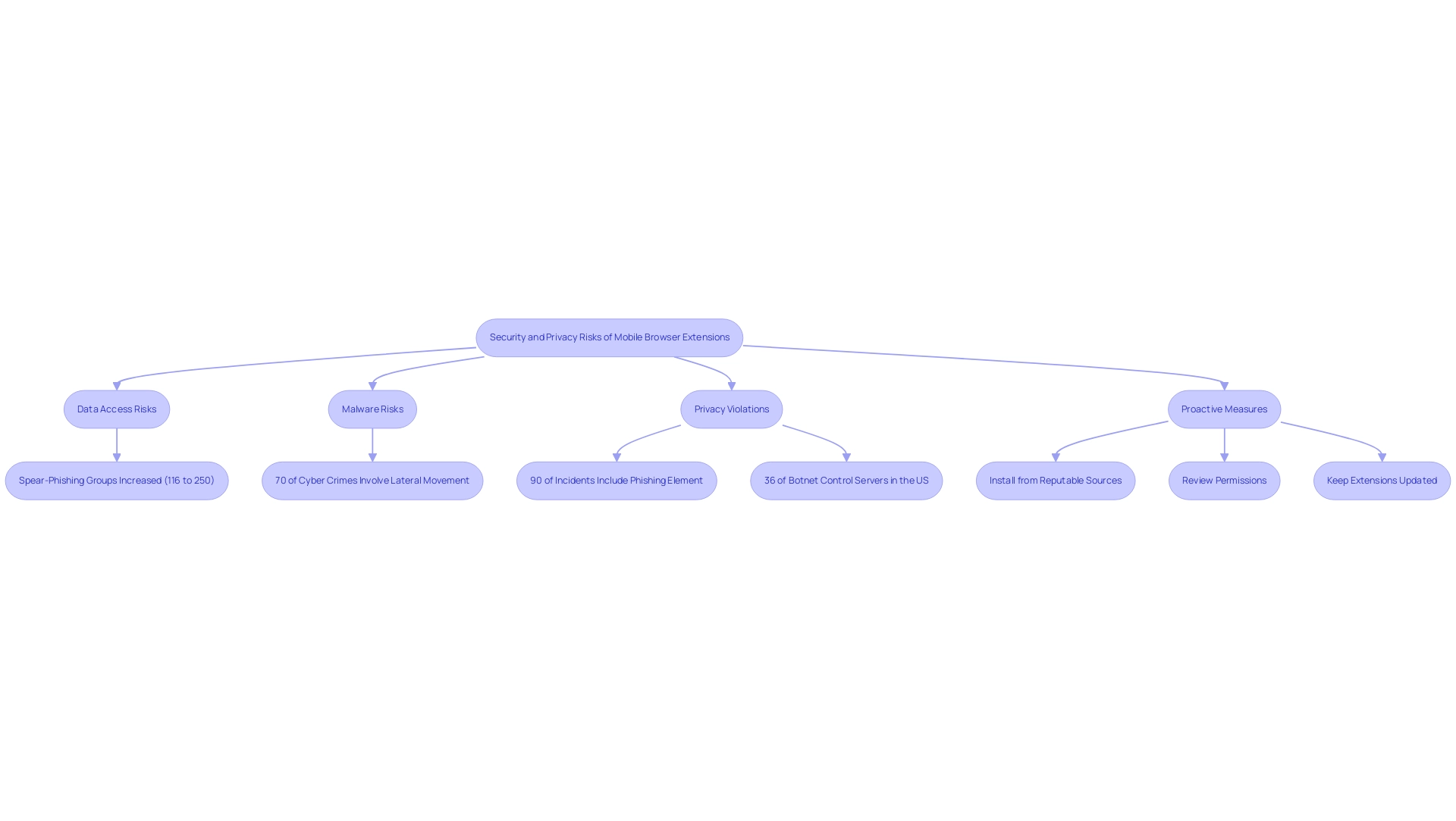Introduction
In an increasingly digital world, mobile browser extensions have emerged as indispensable tools that elevate the browsing experience for users. These small yet powerful software additions allow individuals to customize their mobile web interactions, offering functionalities that enhance productivity, security, and overall usability.
From ad blockers that create a distraction-free environment to password managers that streamline access to sensitive accounts, the array of available extensions is vast and varied. As competition heats up among mobile browsers, understanding the nuances of these extensions becomes crucial for both users seeking optimized experiences and developers aiming to create impactful solutions.
This article delves into the landscape of mobile browser extensions, exploring their types, development processes, and the critical security considerations that users must navigate to make informed choices in their digital endeavors.
Defining Mobile Browser Extensions: An Overview
Mobile browser extensions offer a significant improvement to mobile web browsers, enabling individuals to personalize their browsing experience greatly. By integrating these small software programs, users can access features that might not be natively supported. These extensions offer a range of functionalities, including:
- Ad blocking
- Password management
- Content filtering
All designed to improve productivity and enhance security.
According to recent data, the portable web market is becoming more competitive, with Chrome and Safari occupying the leading spots while Samsung Internet has achieved significant progress. Significantly, Opera possesses a 1.01% market share in the US, demonstrating the varied environment of handheld web applications. As the demand for customized web experiences increases, mobile browser extensions allow individuals to modify their browsing preferences effortlessly.
Additionally, in the realm of advancing mobile technologies, real-world illustrations demonstrate how these enhancements can improve experience and productivity. For example, the most recent statistics show that Google has created 16 Chrome add-ons, with 5 of them (31.25%) exceeding one million individuals, highlighting their broad adoption and effectiveness. Naveen Kumar, a Data and Statistical expert at DemandSage, emphasizes that 'the integration of such additions is crucial for individuals looking to enhance their browsing capabilities in today's digital landscape.'
Overall, the incorporation of mobile browser extensions not only enhances the experience of individuals but also aligns with the requirements of today’s digital environment.

Types of Mobile Browser Extensions: A Platform Perspective
Mobile browser extensions are varied and can be categorized into several main types that improve functionalities and experience across different platforms. These include:
- Ad Blockers: Essential for enhancing the browsing experience, these tools prevent advertisements from loading, allowing individuals to navigate pages without distractions. They are particularly popular, reflecting the increasing demand for cleaner interfaces. Significantly, 5 add-ons created by Google (31.25%) have over 1 million individuals utilizing them, demonstrating the notable influence of well-crafted ad blockers.
- Password Managers: With security as a priority, password managers securely store and autofill credentials, simplifying access to various accounts while protecting sensitive information.
- Productivity Tools: These consist of tools like task managers and note-taking applications, which assist individuals in maintaining organization and efficiency during online activities, reflecting a trend towards more integrated productivity solutions.
- Privacy Protectors: Developed to enhance privacy, these tools block trackers and provide secure online options, addressing the growing consumer concern regarding data privacy.
- Social Media Enhancers: By incorporating social media functionalities directly into the online experience, these tools enable easy sharing and interaction without leaving the current page.
As portable browsing continues to progress, platforms such as Chrome, which holds a significant 66.73% share in the portable web market, nurture vibrant ecosystems of mobile browser extensions aimed at improving engagement and functionality. With 111,933 mobile browser extensions available, the variety of tools supports diverse user needs, particularly in areas like ad blocking and privacy enhancement, as evidenced by the significant adoption of these tools by users seeking a streamlined and secure online experience. Moreover, given that Chrome holds a tablet internet market share of 47.72%, it remains essential for developers to enhance add-ons for this well-liked platform, reinforcing the overall significance of portable web enhancements.

How to Create Mobile Browser Extensions: A Step-by-Step Guide
Creating a mobile browser extensions is a structured process that requires careful planning and execution. Here are the essential steps to guide you through this journey:
- Define the Purpose: Start by clearly articulating the functionality your extension will offer.
This foundational step is critical to align your development efforts with client needs and market demands.
-
Choose a Platform: Identify the mobile browser that best suits your target audience, with Google Chrome dominating the market at 64.16%, followed by Safari at 19.62% and Edge at 4.87%. Considering that the Workflow category is the largest with over 35 thousand tools, and other categories such as Productivity Tools, Fun, Developer Tools, Social, and Accessibility each contain approximately 10,000 tools, prioritizing Chrome for your development can improve visibility and adoption.
-
Set Up Your Development Environment: Prepare your workspace by installing the necessary tools and software development kits (SDKs) tailored to your chosen platform. A well-configured environment is vital for efficient coding and testing.
-
Write the Code: Utilize HTML, CSS, and JavaScript to bring your project's features to life.
These languages are fundamental for creating responsive and engaging features that meet user expectations.
-
Test the Add-on: Conduct thorough debugging and testing within the mobile browser extensions to ensure your add-on functions as intended. This phase is crucial for identifying and rectifying any issues before launch.
-
Publish the Add-On: Adhere to the specific guidelines provided by your chosen platform for submitting your add-on for review. Successfully navigating this process will make your add-on accessible to users, enhancing their browsing experience.
Following these steps not only streamlines the development process but also positions your tool for success in a competitive market. With over 111,933 Chrome add-ons analyzed for 2024, developers must focus on innovation and quality to stand out. As Naveen Kumar, a data and statistical expert, highlights, comprehending the current digital environment is vital for data-driven decision-making in development.

Security and Privacy Concerns with Mobile Browser Extensions
Mobile browser extensions undoubtedly enhance user functionality; however, they also introduce significant security and privacy risks that must not be overlooked. Users should stay alert regarding various crucial issues:
-
Data Access: Many add-ons require access to sensitive information, leading to possible opportunities for misuse and data breaches. This is especially alarming considering that the number of recognized spear-phishing groups has risen, increasing from 116 in 2016 to over 250 by 2018, emphasizing the growing dangers in the digital environment.
-
Malware Risks: Some add-ons contain harmful code that can jeopardize device security, possibly resulting in unauthorized access to personal information or system weaknesses. In fact, recent studies suggest that 70% of cyber crimes targeting financial institutions involve lateral movement, emphasizing the intricate risks associated with seemingly harmless tools.
-
Privacy Violations: Many add-ons track individual behavior without explicit consent, resulting in significant privacy infringements. It has been estimated that 90% of security incidents and breaches in 2019 included a phishing component, which raises alarms regarding the safety of individual data. This alarming statistic underscores the need for users to be cautious with their mobile browser extensions. Moreover, the concentration of botnet control servers in the United States, which hosts 36% of the world's total, poses additional risks, suggesting a pressing need for international cooperation in cybersecurity efforts.
To mitigate these risks, it is crucial for users to adopt proactive measures:
- Install Extensions from Reputable Sources: Only download extensions from trusted developers or official app stores to minimize exposure to malicious software.
- Review Permissions Regularly: Users should consistently examine the permissions requested by mobile browser extensions to ensure they align with their intended functionality.
- Keep Extensions Updated: Regular updates are vital for protecting against known vulnerabilities and exploits.
By adhering to these guidelines, users can harness the advantages of mobile browser extensions while safeguarding their personal information and maintaining control over their privacy.

Conclusion
Mobile browser extensions have transformed the way users interact with the internet, offering a range of functionalities that enhance productivity, security, and overall browsing experience. From ad blockers that create a seamless online environment to password managers that prioritize user security, these tools cater to diverse needs across various platforms. The competitive landscape, dominated by browsers like Chrome and Safari, underscores the importance of understanding the types of extensions available and their impact on user engagement.
Creating a mobile browser extension involves a structured approach, from defining its purpose to navigating the publishing process. Developers must recognize the significance of crafting quality extensions that resonate with user demands, particularly in an era where innovation is paramount. As the number of available extensions grows, so too does the need for developers to stand out through effective functionality and user experience.
However, as beneficial as these extensions can be, they also come with inherent security and privacy risks. Users must remain vigilant about the potential threats posed by extensions, including:
- Data access
- Malware
- Privacy violations
By adhering to best practices—such as installing extensions from reputable sources and regularly reviewing permissions—users can mitigate these risks while enjoying the advantages that mobile browser extensions offer.
In conclusion, mobile browser extensions are essential tools that empower users to tailor their browsing experiences. Both users and developers play critical roles in navigating this dynamic landscape, ensuring that the benefits of these extensions are maximized while minimizing potential risks. As technology continues to evolve, staying informed and proactive will be key to unlocking the full potential of mobile browsing in a secure and efficient manner.





